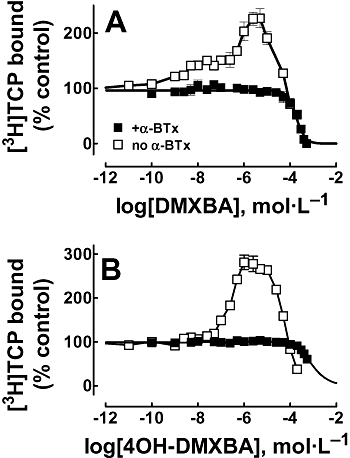Figure 7.

BA-induced modulation of [3H]TCP binding to Torpedo nAChRs in different conformational states. Modulation of [3H]TCP binding elicited by DMXBA (A) or 4OH-DMXBA (B) in the activatable (no α-BTx) and in the resting (+α-BTx) states respectively. nAChR native membranes (0.3 µmol·L−1 nAChR) were equilibrated (1 h) with 5 nmol·L−1[3H]TCP, in the absence (the nAChR is in the resting but activatable state) or in the presence of 1 µmol·L−1α-BTx (the nAChR is maintained resting state), and increasing concentrations of the BA (i.e. 0.01 nmol·L−1–500 µmol·L−1). The IC50 and nH values were obtained by non-linear least-squares fit according to eq. 1, whereas the apparent EC50 values were obtained using an equation similar to eq. 1, where apparent EC50 instead of IC50 was used. The calculated apparent EC50, IC50 and nH values are summarized in Table 3. Shown is the mean ± SD from one experiment performed in triplicate. [3H]TCP, [piperidyl-3,4-3H(N)]-(N-(1-(2-thienyl)cyclohexyl)-3,4-piperidine; 4OH-DMXBA, 3-(4-hydroxy-2-methoxybenzylidene)-anabaseine; α-BTx, α-bungarotoxin; BA, 3-(benzylidene)-anabaseine; DMXBA (or GTS-21), 3-(2,4-dimethoxybenzylidene)-anabaseine; nAChR, nicotinic acetylcholine receptor.
